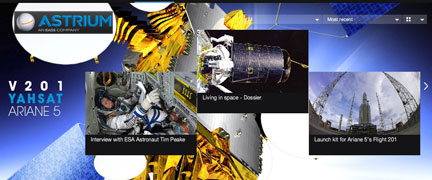
[SatNews] With a ten year life projection, this new camera is set for a place on the Columbus module of the ISS...
On what will probably be its last flight, and the penultimate shuttle mission, the U.S. space shuttle Endeavour, scheduled for launch on April 29, 2011, will transport a new HD video camera to the International Space Station (ISS). The first full HD video camera designed and built by Astrium, Europe’s leading space company, for the ISS on behalf of ESA, was delivered in the record time of eight months. At the end of 2010, a fully qualified and tested prototype of the High Definition Video Camera Assembly (HD-VCA), including the interface unit, was delivered by ESA/Astrium to NASA for upload with this so called mission ULF-6 56 (Utilization and Logistics Flight). The camera has a design life of ten years and is intended to replace one of the existing system cameras on board the Columbus module.
There are a multitude of possible uses for high-quality moving images from on board the ISS that remain crisp and sharp even on large displays or projection screens. They can provide doctors with high-resolution documentation for detailed case histories or can serve as a precision tool for specialists who need to analyse in-orbit hardware and processes when providing technical ground support. Moreover it gives the general public on Earth genuine insights into events in orbit. The product also has potential for commercial exploitation: the HD camera could in future be set up to film through a window while the astronauts are asleep, enabling it to transmit live images of Earth back to the ground station.
To achieve the very short time to orbit for the HD-VCA project, Astrium processed multiple aspects of each phase in parallel, from development through to testing, qualification, and the work on prototype devices. Close cooperation was maintained with ESA throughout. The specifications for the HD video camera for the ISS included employing as many off-the-shelf components as possible, while at the same time limiting or preferably avoiding the risks associated with the use of such components in space. Astrium’s solution was the HD-VCA Box which fits underneath the actual HD camcorder. It serves as an interface enabling the HD camera to operate on power supplied by the Columbus laboratory’s on-board network, and also converts the data recorded by the HD camera into a format that the systems on-board Columbus can read, process and downlink.
No comments:
Post a Comment
hi all my dear friends